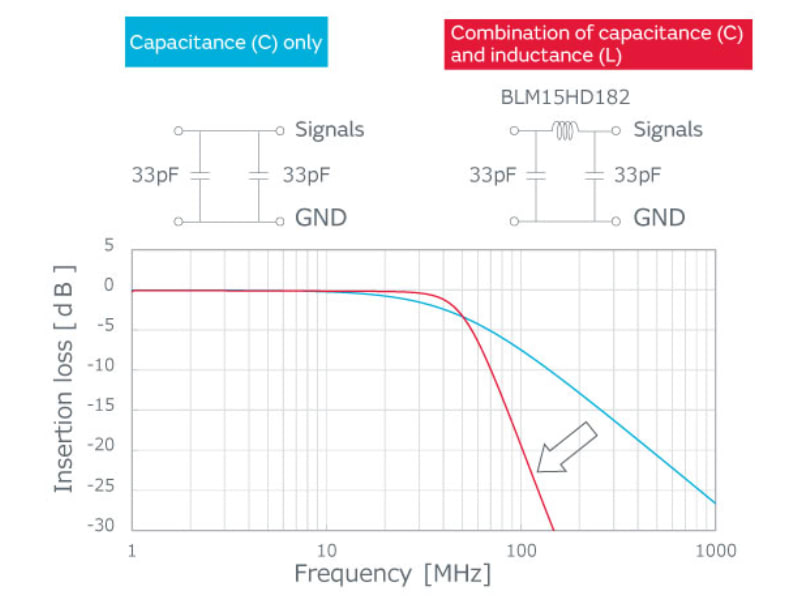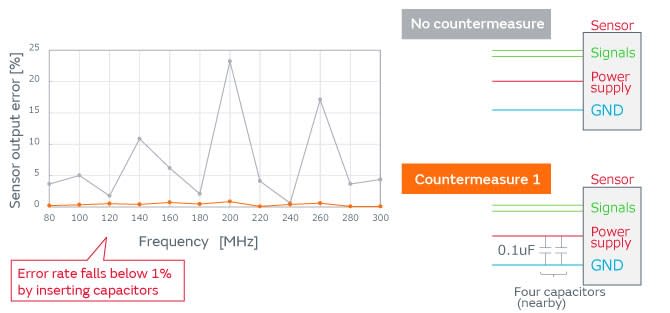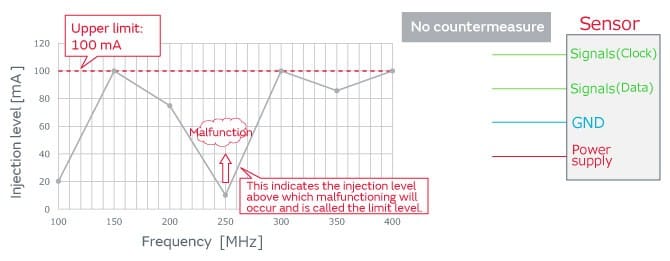Addressing noise concerns to mitigate sensor failure
Follow articleHow do you feel about this article? Help us to provide better content for you.
Thank you! Your feedback has been received.
There was a problem submitting your feedback, please try again later.
What do you think of this article?
Sensors are becoming essential for the functionality of expanding new technologies such as IoT and autonomous driving. With this comes great responsibility to prevent the possibility of serious accidents that could be the result of sensors not correctly transmitting data. Subsequently, noise suppression is an essential component for all types of sensors
The development of MEMS technology has resulted in a single chip sensor becoming prevalent
Typical interfaces used by digital single-chip sensors are I2C & SPI. The signal cut-off frequencies required are proximate to 10MHz for I2C and 50MHz for SPI. The Murata BLM15HB/HD series chip ferrite beads are suitable for such applications, as per below.
Single-chip sensors mainly consist of single, power & GND lines. Additionally, communication can be achieved using a number of signal lines including clock & data, all of which can be affected when noise is applied.
Noise on digital signal lines can produce erroneous results that can affect the sensor’s parameters causing communication distortion or loss which ultimately can cause a fault in the application.
We actually introduced noise to the digital signal lines of a particular accelerometer for evaluation and verified the malfunction as stopping communication.
Analog front end includes an amplifier & analog/digital conversion circuit. If their power supply fluctuates this can compromise these circuits' performance.
Noise can be introduced to the power line of an accelerometer to allow evaluation, confirming the fault where the output has been disrupted.
Single-chip sensors come in a diverse assortment of forms, types & functions. The noise countermeasure requirements to prevent sensor failure are constant:
- To ensure the correct signals required for the sensor’s operation pass efficiently and successfully
- To prevent affected noise that would cause the sensor to fail
- To ensure that the filter is mounted in the proximity of the sensor to ensure effectiveness
Countermeasures for Power Line Noise
Filters with high insertion loss, capable of dealing with a wide bandwidth from low to high frequencies are suitable for countering noise in power lines.
Treating noise purely with capacitors requires a large capacitance value that can cover low frequency & a low ESL capacitor to ensure high-frequency insertion loss
The combination of capacitors with an inductor can provide advantageous insertion loss.
By arranging sufficient capacitance at the sensor side from the inductor, a more effective filter against noise is achieved in a multi-level configuration.
Signal line noise countermeasures
Countering noise for data/clock signal lines requires filters having low insertion loss at the signal frequencies that should be passed.
Countermeasures using only capacitors are possible, if noise levels are small or when the frequencies of the signal and noise are separated. Yet if the signal frequency and the noise frequency are close, it becomes crucial to configure filters having sharp insertion loss characteristics by combining the use of inductors and capacitors.
 In Conclusion: When Using Inductors
In Conclusion: When Using Inductors
If an inductor is inserted in a specific line only, the line can become unbalanced and conversion to normal mode (a potential difference) occurs. Consequently, there is the potential for failures as the result of noise getting worse. When inserting inductors, it is critical that the same part number is used in all of the lines.
Ferrite beads are inductive type filters that not only block noise with high impedance but can absorb noise energy as a loss by the ferrite. Thus achieving higher noise countermeasure effectiveness.
Introduced here the noise countermeasure examples that represent a BCI test which is a conduction immunity standard directed at onboard equipment.
We examined countermeasures and effects against sensor malfunctions that are caused by noise on the power supply line and the signal line.
Examples of power supply line noise countermeasures
The sensor output value error (output error) occurs as a result of noise on the sensor power line. The noise level injected into the power supply line was kept constant, and the output error before and after the countermeasure was examined.
Since the malfunction of the sensor output value is caused by the normal mode noise of the power supply line, four low ESL capacitors of 0.1μF were inserted near the sensor.
As a result, the output error of the sensor was suppressed to less than 1%.
If further noise countermeasures are required, the inductor and the capacitor can be configured as a pi-type filter as mentioned previously.
Examples of signal line noise countermeasures
The sensor communication may stop due to the effect of the noise on the signal lines of the sensor. The injected noise level was raised, and the level of the proper operation limit (Areas where no defects occurred) was examined.
|
Initial |
Resistance to malfunctioning differs greatly with frequency. |
|
Countermeasure 1 |
Addition of capacitors improves resistance to malfunctioning at 100MHz and 250MHz. |
|
Countermeasure 2 |
A configuration of ferrite beads and capacitors improves resistance to malfunctioning at 200MHz and 250MHz. |
|
Countermeasure 3 |
To obtain a balance, a pi-type filter is configured for the power supply line and ferrite beads are also added to the ground (GND) line. This improves resistance to malfunctioning across all frequency ranges. |
By implementing countermeasure 3 (recommended circuit), it was confirmed that the noise resistance was improved over the entire frequency bandwidth.
This article presents the necessity of countermeasures for the noise that affects sensors and the recommended circuits, as well as the anticipated problems that are the mechanisms of sensor malfunctioning due to noise, and examples of countermeasures.
There are a variety of products available to help you solve problems and select products from Murata.
▼ See the product range below ▼
|
Series name |
Applications |
Part Number |
Impedance |
Rated Current |
DC Resistance |
|
BLM15HB series |
For Consumer |
120Ω |
300mA |
0.7Ω |
|
|
220Ω |
250mA |
1Ω |
|||
|
For Automotive (Infotainment) |
120Ω |
300mA |
0.7Ω |
||
|
220Ω |
250mA |
1Ω |
|||
|
For Automotive (Powertrain/Safety) |
120Ω |
300mA |
0.7Ω |
||
|
220Ω |
250mA |
1Ω |
|
Series name |
Applications |
Part Number |
Impedance |
Rated Current |
DC Resistance |
|
BLM15HD series |
For Consumer |
600Ω |
300mA |
0.85Ω |
|
|
1000Ω |
250mA |
1.25Ω |
|||
|
1800Ω |
200mA |
2.2Ω |
|||
|
For Automotive (Infotainment) |
600Ω |
300mA |
0.85Ω |
||
|
1000Ω |
250mA |
1.25Ω |
|||
|
1800Ω |
200mA |
2.2Ω |
|||
|
For Automotive (Powertrain/Safety) |
600Ω |
300mA |
0.85Ω |
||
|
1000Ω |
250mA |
1.25Ω |
|||
|
1800Ω |
200mA |
2.2Ω |














